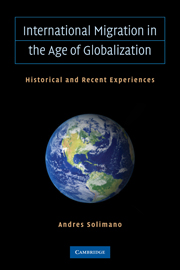Book contents
- Frontmatter
- Contents
- Acknowledgments
- 1 Introduction: Understanding the Trends, Themes, and Strata of International Migration
- 2 Why People Move or Stay Put: International Migration Is the Result of Compelling and Conflicting Factors
- 3 What Happens When International Migration Happens? The Dilemmas Posed by Migration
- 4 How Empires, Policy Regimes, and Economic Imperatives Influenced the Mobility of Capital and People in the 20th Century
- 5 Latin America: Where Volatile Economic Development, Political Crises, Poverty, and Remittance Income Is a Laboratory for Studying the Determinants of International Migration
- 6 Who Migrates and What They Offer: A Focus on People and Elites with Talent, Knowledge, and Entrepreneurial Skills
- 7 A Fair and Orderly International Migration Process Requires a Global Social Contract
- References
- Index
5 - Latin America: Where Volatile Economic Development, Political Crises, Poverty, and Remittance Income Is a Laboratory for Studying the Determinants of International Migration
Published online by Cambridge University Press: 05 June 2012
- Frontmatter
- Contents
- Acknowledgments
- 1 Introduction: Understanding the Trends, Themes, and Strata of International Migration
- 2 Why People Move or Stay Put: International Migration Is the Result of Compelling and Conflicting Factors
- 3 What Happens When International Migration Happens? The Dilemmas Posed by Migration
- 4 How Empires, Policy Regimes, and Economic Imperatives Influenced the Mobility of Capital and People in the 20th Century
- 5 Latin America: Where Volatile Economic Development, Political Crises, Poverty, and Remittance Income Is a Laboratory for Studying the Determinants of International Migration
- 6 Who Migrates and What They Offer: A Focus on People and Elites with Talent, Knowledge, and Entrepreneurial Skills
- 7 A Fair and Orderly International Migration Process Requires a Global Social Contract
- References
- Index
Summary
From the mid-19th century until the early decades of the 20th, Latin America was considered a “land of opportunity,” primarily for the European emigrant population. During that period, countries such as Argentina, Chile, Brazil, Mexico, and Uruguay received significant contingents of immigrants; Argentina, in particular, was the main destination country for about 6 million people coming mostly from Italy and Spain. In addition to people, these countries received capital and direct investments, primarily from England and Germany, the two leading world financial centers until the 1920s. Thus, both labor and capital flowed to Latin American countries from the mid to the end of the 19th and the beginning of the 20th centuries in search of the good employment and investment opportunities offered by the region. The situation did not last forever. In fact, during the final decades of the 20th century, South America on the whole became a continent of net emigration – that is, a net “exporter” of people in which the majority of countries tended to have a larger stock of emigrants than of immigrants. However, as of the early 2000s, some countries are still net-immigration economies, such as Costa Rica, Argentina, and Venezuela. This chapter seeks to identify the main forces that drive migration flows to, from, and within the Latin American region, based on several of the determinants discussed in Chapter 2 of this book.
- Type
- Chapter
- Information
- International Migration in the Age of Crisis and GlobalizationHistorical and Recent Experiences, pp. 117 - 156Publisher: Cambridge University PressPrint publication year: 2010



